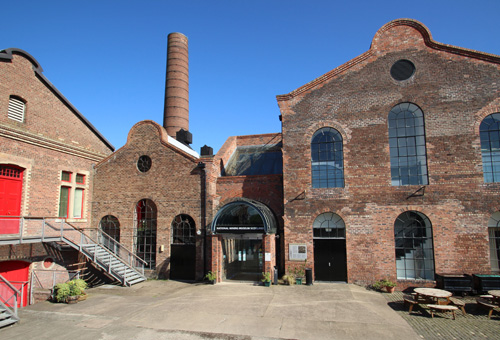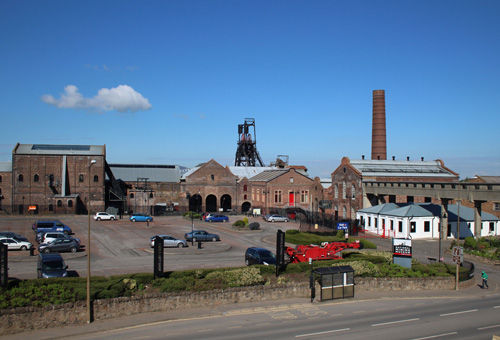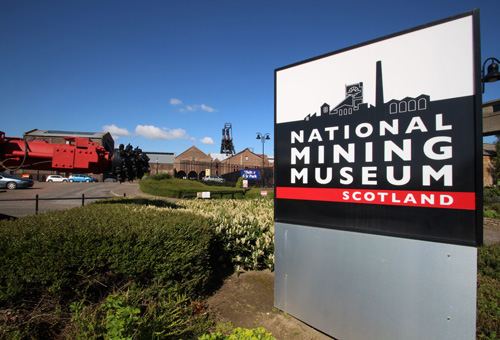About National Mining Museum Scotland
National Mining Museum Scotland is a 5 Star visitor attraction and winner of the Association of Scottish Visitor Attractions “Best Visitor Experience” Award in 2009 and 2013. The museum provides a great day out for all ages! We’re based at one of the finest surviving examples of a Victorian colliery in Europe, the Lady Victoria Colliery at Newtongrange, just nine miles south of Edinburgh. Visitors to the museum will marvel at the sheer size of the place, be astounded by the engineering brilliance behind all the machinery and retrace the footsteps and struggles of the thousands of miners and their families before them.
The Colliery
The Lady Victoria Colliery, home of National Mining Museum Scotland, was opened in 1895 as Scotland’s first super-pit. It ceased production in 1981 and now serves as an example of one of the best preserved Victorian Collieries in Europe. The four-acre Midlothian site effectively captures the developments in mining over generations and highlights include the most powerful steam winding engine in Scotland; the most extensive preserved suite of Lancashire Boilers in the UK, and the only extant timber Dredger in Europe.
The public areas of the Museum occupy a small proportion of the site and are the result of successive programmes of Heritage Lottery Fund, European Regional Development Fund and Historic Scotland capital development. A Grade ‘A’ listed site, the terrain bears the scars of industrial development, environmental exploitation and exposure to the elements. The majority of the surface structures are composed of brick, steel and iron and, despite their architectural significance, some remain in a derelict state.
In 2009, the Museum embarked on an ambitious Scottish Government-funded conservation project to preserve the Tippler Floor, Picking Tables, Elevator Shed and brick-vaulted Undercroft. Each space had a vital role in the processing of coal and its preparation for delivery and use and it was vital to conserve these artefacts for those generations who have no live connection or understanding of mine working in an increasingly electronic and digital age. The Project was carried out by a dedicated team of architects, structural engineers, project managers and builders. Their primary objective has been to stabilise the structures, rendering them safe for future access, and to make them windproof and watertight.
The Undercroft
The Undercroft is the name of the arched area underneath the colliery buildings. During the colliery’s operational life, it was a hub of activity.
One of the main reasons for the location of the Lady Victoria Colliery was its proximity to the Waverly Railway line, which ran along the perimeter of the site and made it an ideal location for transporting coal to the textile mills in the Borders and the docks in Leith.
The Undercroft contained a series of railway sidings, some of which are still visible in particular areas. Wagons pulled into these sidings and were filled with coal, once it had been cleaned and graded, through tipplers above. This coal did not just come from the Lady Victoria Colliery, but also from the neighbouring collieries at Easthouses and Lingerwood, which were connected to the Lady by branch lines.
After the Colliery’s closure in 1981, the Undercroft lay unused for many years and grew structurally unstable. However, in 2009 National Mining Museum Scotland gained Capital funding to secure the area and make it safe. This work was completed in 2011. Although still not routinely open to the public due to the unevenness of the ground, the Undercroft may now be visited by appointment with a guide.
In 2011, the Museum was granted further funding from the Museums Galleries Scotland Recognition scheme to consolidate its large object collections, and move many of the large items previously housed outdoors into new homes in the Undercroft. This will shelter them from adverse weather and ensure that they are adequately preserved.
Among the objects now housed in the Undercroft are two railway wagons that were moved from Prestongrange Museum as part of the Recognition project. These core items from the National Mining Museum Scotland collection had resided at Prestongrange for two decades and bear the livery of the Lothian Coal Company and the National Coal Board, so are symbols of key periods in the Lady Victoria’s history.
National Mining Memorial Centre
In September 2013 the museum restored a three storey building, previously the washery to the Colliery, to form Scotland’s first national mining memorial to the coal mining industry and its communities. As well as space for quiet contemplation and the recording of memories in the Reminiscence Register, the Centre contains a small exhibition gallery that examines developments in working conditions and health and safety in mining and a storytelling space, complete with resident canaries.
Energy Lab
While the Lady Victoria site is a memorial to Scotland’s deep coal mining industry, the Energy Lab looks towards Scotland’s energy future. Set in the Portacabin in which Professor Stephen Salter pioneered wave and tidal energy in the 1970s, the Lab is an interactive classroom in which young people can learn about alternative forms of energy. Some will hopefully discover bright prospects as the engineers of the future.
Learning Through Play
For younger audience the Interactive Zone provides a variety of fun and engaging activities to facilitate learning about the geology and mechanics behind coal and mining. The adjacent Mini Miners’ Softplay Centre caters from babies to 8 year olds and is a colourful, exciting space that encourages exploration, teamwork and fun, all set against an entertaining, mining-themed backdrop.
Special Exhibition Gallery
This versatile space has opened up NMMS’s capacity to develop and display temporary exhibitions. The gallery, opened in 2012, has enable the museum to steadily build a changing programme of exhibitions including the showcasing of our animation project “Seams in the Dark”, an exploration of Scotland’s archaeology in partnership with the Society of Antiquities. Currently, the gallery is hosting a celebration of the Museum’s anniversary: “Coal, Canaries & Cake; 30 Years of National Mining Museum Scotland.”
Additional information:




